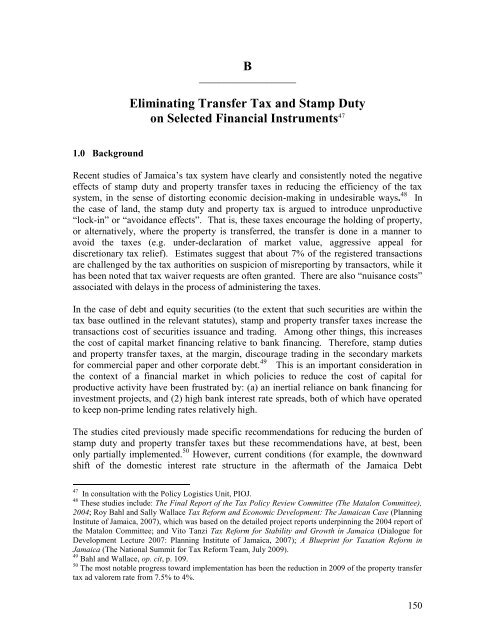PIOJ Growth-Inducement Strategy - Planning Institute of Jamaica
PIOJ Growth-Inducement Strategy - Planning Institute of Jamaica
PIOJ Growth-Inducement Strategy - Planning Institute of Jamaica
Create successful ePaper yourself
Turn your PDF publications into a flip-book with our unique Google optimized e-Paper software.
B<br />
____________________<br />
Eliminating Transfer Tax and Stamp Duty<br />
on Selected Financial Instruments 47<br />
1.0 Background<br />
Recent studies <strong>of</strong> <strong>Jamaica</strong>’s tax system have clearly and consistently noted the negative<br />
effects <strong>of</strong> stamp duty and property transfer taxes in reducing the efficiency <strong>of</strong> the tax<br />
system, in the sense <strong>of</strong> distorting economic decision-making in undesirable ways. 48 In<br />
the case <strong>of</strong> land, the stamp duty and property tax is argued to introduce unproductive<br />
“lock-in” or “avoidance effects”. That is, these taxes encourage the holding <strong>of</strong> property,<br />
or alternatively, where the property is transferred, the transfer is done in a manner to<br />
avoid the taxes (e.g. under-declaration <strong>of</strong> market value, aggressive appeal for<br />
discretionary tax relief). Estimates suggest that about 7% <strong>of</strong> the registered transactions<br />
are challenged by the tax authorities on suspicion <strong>of</strong> misreporting by transactors, while it<br />
has been noted that tax waiver requests are <strong>of</strong>ten granted. There are also “nuisance costs”<br />
associated with delays in the process <strong>of</strong> administering the taxes.<br />
In the case <strong>of</strong> debt and equity securities (to the extent that such securities are within the<br />
tax base outlined in the relevant statutes), stamp and property transfer taxes increase the<br />
transactions cost <strong>of</strong> securities issuance and trading. Among other things, this increases<br />
the cost <strong>of</strong> capital market financing relative to bank financing. Therefore, stamp duties<br />
and property transfer taxes, at the margin, discourage trading in the secondary markets<br />
for commercial paper and other corporate debt. 49 This is an important consideration in<br />
the context <strong>of</strong> a financial market in which policies to reduce the cost <strong>of</strong> capital for<br />
productive activity have been frustrated by: (a) an inertial reliance on bank financing for<br />
investment projects, and (2) high bank interest rate spreads, both <strong>of</strong> which have operated<br />
to keep non-prime lending rates relatively high.<br />
The studies cited previously made specific recommendations for reducing the burden <strong>of</strong><br />
stamp duty and property transfer taxes but these recommendations have, at best, been<br />
only partially implemented. 50 However, current conditions (for example, the downward<br />
shift <strong>of</strong> the domestic interest rate structure in the aftermath <strong>of</strong> the <strong>Jamaica</strong> Debt<br />
47 In consultation with the Policy Logistics Unit, <strong>PIOJ</strong>.<br />
48 These studies include: The Final Report <strong>of</strong> the Tax Policy Review Committee (The Matalon Committee),<br />
2004; Roy Bahl and Sally Wallace Tax Reform and Economic Development: The <strong>Jamaica</strong>n Case (<strong>Planning</strong><br />
<strong>Institute</strong> <strong>of</strong> <strong>Jamaica</strong>, 2007), which was based on the detailed project reports underpinning the 2004 report <strong>of</strong><br />
the Matalon Committee; and Vito Tanzi Tax Reform for Stability and <strong>Growth</strong> in <strong>Jamaica</strong> (Dialogue for<br />
Development Lecture 2007: <strong>Planning</strong> <strong>Institute</strong> <strong>of</strong> <strong>Jamaica</strong>, 2007); A Blueprint for Taxation Reform in<br />
<strong>Jamaica</strong> (The National Summit for Tax Reform Team, July 2009).<br />
49 Bahl and Wallace, op. cit, p. 109.<br />
50 The most notable progress toward implementation has been the reduction in 2009 <strong>of</strong> the property transfer<br />
tax ad valorem rate from 7.5% to 4%.<br />
150
















